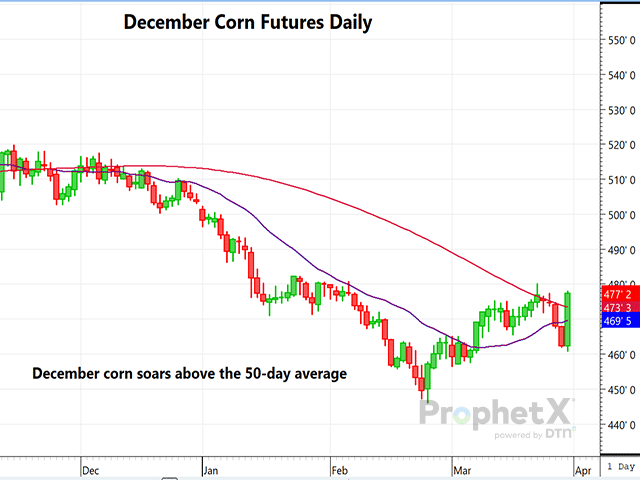USDA Report Review
Corn Soars Following Bullish Prospective Planting and Quarterly Stocks Surprise
USDA's March 1 Prospective Plantings and quarterly Grain Stocks reports, released Thursday, began the day with few, if any, traders expecting a big surprise. If anything, traders came into the report with a bearish outlook. That turned out to be dead wrong, with the estimated corn planting number falling about 2 million acres below the average pre-report estimate from the Dow Jones survey of 18 analysts.
CORN
It appears that the USDA, never at a loss for a report surprise, may have caught fund managers off guard with a sharply lower planting number than trade expectations. With the Dow Jones estimate of 18 traders and analysts looking for 92 million acres to be planted in 2024, the survey-based planting estimate came in much lower than that at just 90 million acres and down 5% from a year ago. It would imply that farmers are likely to respond to lower prices and profitability to slash planting plans. That news sent funds, which came into the report still short an estimated 250,000 contracts, scrambling to cover. Both old- and new-crop corn futures soared as a result with December vaulting and closing well above the key 50-day moving average. The corn planting number was down 5% from last year. Corn acres in 38 of 48 states were unchanged or lower compared to last year.
On the March 1 stocks number, corn supplies were also lower than trade expectations at 8.35 bb, about 85 mb below expectations but still 13% (951 mb) higher than a year ago. Of that total, on-farm stocks were 5.08 bb and 24% higher than last year, while off-farm stocks of 3.27 bb were 1% lower than a year ago. The December 2023 through February 2024 disappearance was 3.82 bb compared to 3.42 bb one year ago, as corn exports and use for ethanol were higher.
SOYBEANS
Unlike corn, the soybean prospective planting report was very close to expectations at 86.5 million acres and up 3% from last year. The trade had been looking for 86.3 ma. Planted acres were estimated to be unchanged or higher in 24 of the 29 reporting states. The news was neutral to the soybean market.
P[L1] D[0x0] M[300x250] OOP[F] ADUNIT[] T[]
The March 1 stocks for soybeans were reported to be 1.85 bb or about 158 mb higher than a year ago and the highest in two years. On-farm stocks, as in corn, were 24% higher than a year ago at 933 mb, while off-farm stocks of 912 mb were down 3% from last year. The December through February disappearance was 1.16 bb, and that is 13% lower than a year ago, no doubt a function of weaker-than-expected export sales.
WHEAT
All wheat planting was estimated by the USDA at 47.5 million acres and more than 2 million acres (4%) below last year, but close to market expectations. Of the total, winter wheat came in much lower than expected at 34.1 ma and 7% below a year ago. The trade had been looking for roughly one million acres more than that. Of the total winter wheat, hard red was 24.3 ma, soft red 6.26 ma and white winter 3.59 ma. Other spring wheat, at 11.3 ma was 400,000 acres higher than the trade estimate. Hard red spring figured to be 10.7 ma, and Durum wheat, at 2.03 million acres were up 22% from a year ago. Soft red wheat planting was down 600,000 acres, hard red up 300,000 acres, with hard red spring up 200,000 acres, and durum wheat rising by 350,000 acres.
March 1 all wheat stocks were reported to be higher-than-expected 1.090 bb and up 16% from a year ago. I think we can credit the sluggish export program for much of that, with December through February disappearance at 334 mb and down 10% from a year ago. On-farm wheat stocks were 272 mb and 20% higher than last year, while off-farm stocks were also up 14% at 816 mb.
The wheat report was somewhat neutral, but the by-class changes sent Minneapolis lower with winter wheat markets Chicago and KC closing higher for the day.
As an aside, the all-cotton planted acres were reported to be up 4%, at 10.7 million acres.
FINAL THOUGHTS
The big surprise of the day came in the form of sharply lower-than-expected corn acres, and the market responded in kind, with new-crop December futures closing up more than 15 cents and sending shorts scrambling to take off some risk. Any survey-based estimate leaves plenty of room for error, but one thing seems clear for corn -- the trend appears to be slowly turning to higher demand and lower stocks based on the March stocks and planting data. The close of both old- and new-crop corn futures rose above the 50-day moving average and could encourage funds to continue to abandon, or at least lighten up on short positions in the coming days.
The wheat and soy markets, on the other hand, both revealed lower usage in the latest quarter, suggesting still tepid export demand for both. Planting estimates for both came in close to expectations but perhaps the biggest surprise was the winter wheat planting estimate falling one million acres below trade estimates, with spring and durum wheat higher sending winter wheat markets up and Minneapolis down at the close.
At the close on Thursday, December corn futures finished up 15 1/2 cents, while November soybeans closed 2 3/4 cents higher, while spot May ended lower on larger stocks. New crop Kansas City July futures gained 5 3/4 cents by the close. Minneapolis May wheat finished 4 1/2 lower while Chicago spot wheat surged to a 12 3/4 cent higher finish.
Dana Mantini can be reached at dana.mantini@dtn.com.
(c) Copyright 2024 DTN, LLC. All rights reserved.



